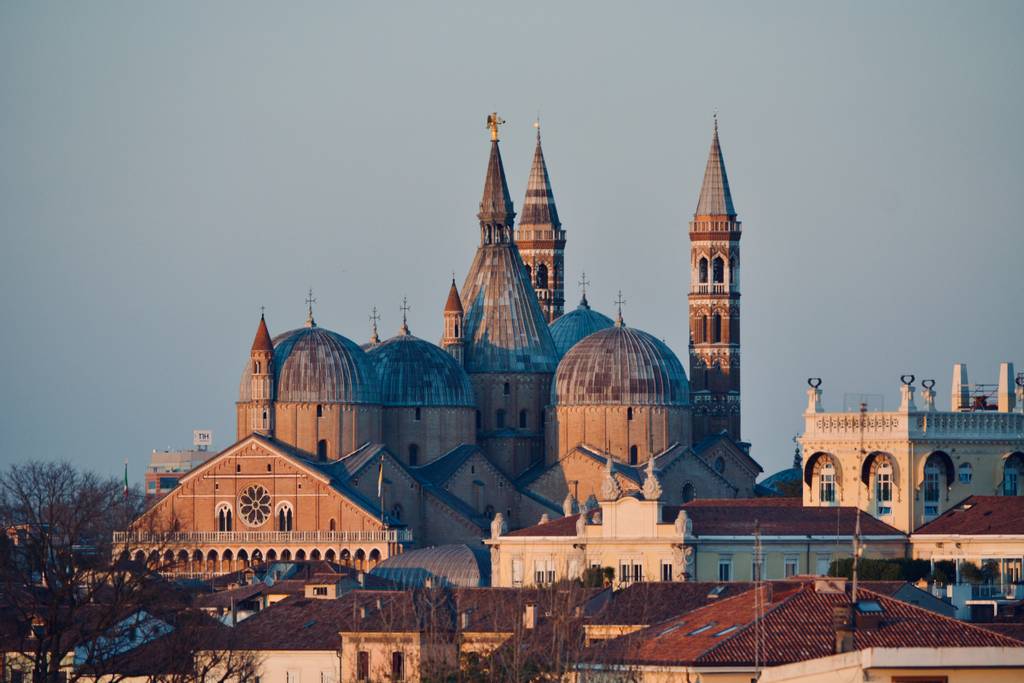The Saint's City
Padua, the city of Saint Anthony, is a modern and lively city with a fusion of art, faith, well-being, and cultural tourism.

Padua is a city with an outstanding tourism offer that combines a great historical-cultural heritage, centuries-old traditions, faith, and well-being. The city is located in the heart of the Po Valley, in a privileged position in the northeast of Italy, a few kilometres from the Venice Lagoon. Just outside the city are the great green lungs of the Euganean Hills (Colli Euganei) and the centre of one of the largest spas in Europe, the Euganean Spas (Terme Euganee).
Aeneid, the Latin epic poem written by Virgil, mentioned that Padua was founded around 1183 BC by the Trojan prince Antenor. Later, during the period of the Roman Empire, the city developed as an important cultural and commercial hub with the name Patavium.
After a few centuries of peace and prosperity under the protective wing of the Empire, Padua was overwhelmed by the invasions of the barbarians: in 452 the city was devastated by the Attila the Hun, afterwards, it fell under the control of the Goths before being seized by the Lombard king Alboin in 568 and ultimately being completely razed on the ground by the Lombard king Agilulf in 602. In the second half of the 8th century the Franks took over the command of the city from the Lombards, and in 899 it was stormed and sacked by the Hungarians.
Over the next centuries, Padua recovered from these ravages, grew in power, and enjoyed a period of calm and prosperity. It became an important religious centre and in 1226 a Portuguese Franciscan, Fernando Martins de Bulhões, chose the city of Padua as his seat. He would become famous all over the world as Saint Anthony of Padua marking forever the history of the city. Soon after his death began the construction of the basilica commonly known today as "Il Santo" (The Saint)
Padua also came to be a nucleus of early humanist research and since 1222 the city is home to one of the oldest and most prestigious universities in the world. The presence in the city of Giotto and Petrarch made it one of the artistic and cultural capitals of the 14th century under the Carrarese dominion. It was a period of great artistic and cultural flourishing due to the many commissions of the Paduan patrons of arts. The works carried out by the leading artists of the time were a completely new way of representing narration in painting, marking the beginning of revolutionary development in the history of mural painting. The fresco cycles painted in different secular and religious buildings throughout the city are now reunited as part of the UNESCO World Heritage propriety, the Padova Urbs Picta.
In 1405, after a long and hard-fought struggle, Padua had to definitively surrender to the Venetian army and become a province of the Venetian Republic which lasted until the fall of the republic in 1797. This period shaped Padua as one of the main centres of pre-humanism and therefore of the Renaissance, thanks to the contribution of great masters such as Donatello, Mantegna, and Titian.
During the years of the Serenissima, the University also prospered and attracted students and teachers from all over Europe, including Galileo Galilei who was a professor of Mathematics for 18 years after moving to the University of Padua in 1592.
The Venetian rule also meant a time of prosperity and this contributed to the construction of numerous noble Venetian villas, and elegant patrician residences, among which stand out those designed by the Paduan architect Andrea Palladio.
After the Venetian Republic came to an end, Padua was ceded to the Habsburgs. It was a time of industrial development and one of the first Italian rail tracks, Padua-Venice, was built in 1845. But it was also a time of uproar and in 1848, the year of revolutions, the students rose against the Austrian rule, and the University and the Caffè Pedrocchi were turned into battlegrounds.
Despite its tumultuous history, the city flourished in the second part of the 20th century and became one of the richest and most economically active regions of modern Italy.
Present-day Padua is a livable and active city, animated by the many young people who attend the University and at the same time proud of its culture, traditions, and rich history.
We welcome all contributions, no matter how small. Even a spelling correction is greatly appreciated.
All submissions are reviewed before being published.
Continue to changelogWe welcome all contributions.
All submissions are reviewed before being published.
